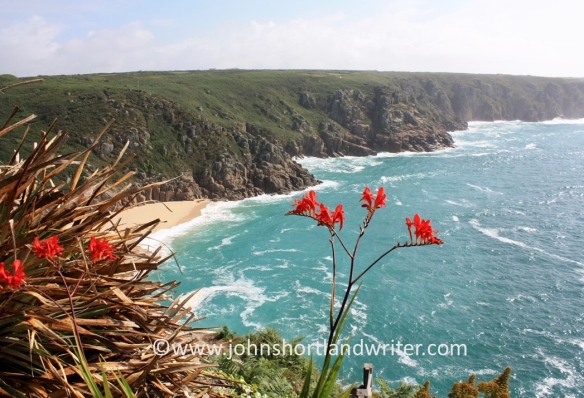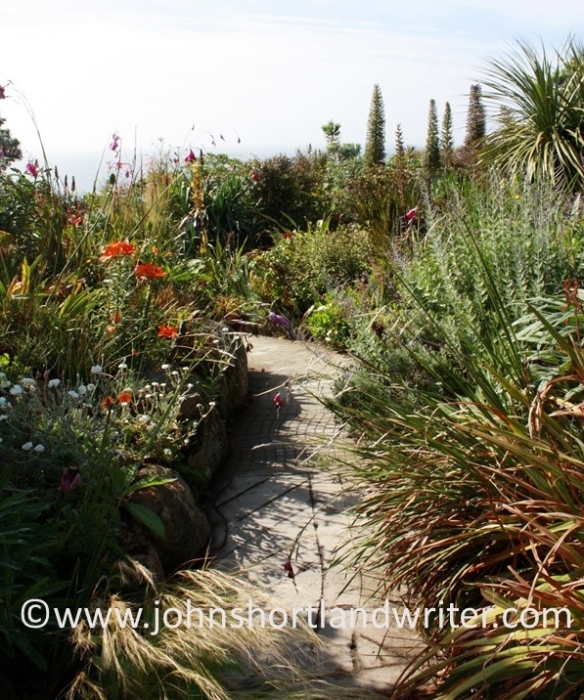The secret valley close to where I live is encircled by hills. The steeper slopes as well as the valley floor, which is subject to regular flooding, have not been ploughed in living memory and, quite probably, not at all. As a consequence, providing the sheep or cattle haven’t grazed them too heavily, the grass sward is peppered with wild flowers. In the spring there are cowslips and, as the year advances, orchids and the delicate, nodding flower heads of Quaking Grass can be found.

over 97% of old flower meadows have been destroyed since 1930
Although the orchids are a joy, the plants that excite me most are the wild, culinary herbs, the scarcest of which is wild thyme, for it grows only on the driest and steepest of the banks. Thyme can, of course, be readily bought in supermarkets all year round, either dried or fresh, and it is easily grown at home in a pot or window box. All it requires is sunny spot and a free-draining and not over-rich potting compost to thrive.

Shakespeare’s wild thyme
Whenever, I see the wild thyme I always think of Shakespeare’s immortal line, I know a bank where the wild thyme grows. The secret valley is only about twenty-five miles as the crow flies from Stratford-upon-Avon and so there is a rather satisfying sense of connection across the centuries, as well as the miles, whenever the tiny flowerheads peep out from amongst the grass. In fact, Shakespeare’s words and the secret valley’s meadows were inspiration for an early blog post of mine on creating wild flower meadows way back in 2009! You’ll find that one by clicking on this link.
Thyme’s cousin, marjoram is nowhere near as diminutive in both its scent or its flowering. Standing tall on wiry, strong stems it is a magnet for bees and butterflies. Once again, it is a useful garden plant not just for kitchen use but also good as a front of border edging. It spreads steadily but is never a nuisance. In the wild, grasses and other plants prevent it from becoming too dominant but when you discover a good stand of it swaying in a warm, summer breeze the perfume is unforgettable.

A Ringlet butterfly feeding on Marjoram
One plant that is often overlooked although it is quite tall is Salad Burnet. Its dark red, tightly buttoned flowers can be used in floral arrangements but it is only the young leaves that are edible. Used in salads and also added to sauces, they have a mild and slightly bitter cucumber flavour. Sharp eyes are needed to find it growing amongst tall grasses for its rosette of pinnate leaves hug the ground. Fortunately, once again, there is no need to forage from the wild for they grow happily in the garden.

You need to look carefully amongst the taller grasses to spot Salad Burnet
Along the lane that leads out of the valley, and also somewhat surprisingly, growing amongst trees close to our house, chives can be found. A common kitchen ingredient and native to Britain they have a remarkably widespread range over much of the northern hemisphere, growing across Europe, the Middle East, Asia and North America. Although they are plentiful, how much easier it is to pick them from a pot close to the kitchen door!

chives growing through the leaf litter of open woodland
It is one of the pleasures of summer to seek out these wild food plants for it is reassuring to know that, if ever the need arose, they are there to flavour my meals. However, even under lockdown, there is never a real need to harvest a wild plant; how much better to leave it for the bees and butterflies?

Marbled White butterflies thrive in old meadows








 Wild flower meadows are quite easy to create whether on the big scale or in the garden. Of course, the species rich meadows of the Chilterns and Cotswolds have evolved over centuries and have a wealth of insect and plant life to show for it. In the garden you just have to be a little more realistic and be grateful for every bug and butterfly that comes along and colonises it. Hopefully wild orchids, like the Pyramidal orchids below, will arrive too.
Wild flower meadows are quite easy to create whether on the big scale or in the garden. Of course, the species rich meadows of the Chilterns and Cotswolds have evolved over centuries and have a wealth of insect and plant life to show for it. In the garden you just have to be a little more realistic and be grateful for every bug and butterfly that comes along and colonises it. Hopefully wild orchids, like the Pyramidal orchids below, will arrive too. The golden rule of all meadows is to reduce fertility. As soon as fertility rises, usually through feeding, the grass sward thickens and out competes the flowers. The photo below is of ‘our’ bank and shows, as a golden haze, the unimproved grassland – thin, tall and sparse and too steep for the tractors to get onto and spray. The brighter green grass above and below is where the tractors can reach, the grass has been fed and, consequently, there are few wild flowers.
The golden rule of all meadows is to reduce fertility. As soon as fertility rises, usually through feeding, the grass sward thickens and out competes the flowers. The photo below is of ‘our’ bank and shows, as a golden haze, the unimproved grassland – thin, tall and sparse and too steep for the tractors to get onto and spray. The brighter green grass above and below is where the tractors can reach, the grass has been fed and, consequently, there are few wild flowers. Late summer wild flower meadows require a different maintenance regime to those which have an abundance of spring flowers and, as it is that time of year, I shall concentrate on the former. Now is the time to cut the ‘hay’ whether on the bigger scale such as in this orchard or, by hand, in the garden. It is important to get the timing right – you need to leave it late enough for the seeds to fall from their heads to increase more. Leave it too late and bad weather knocks the grass and plants flat to the ground when it becomes a devil of a job to cut. The difference is a task that is a joy to do or one that is totally hateful!
Late summer wild flower meadows require a different maintenance regime to those which have an abundance of spring flowers and, as it is that time of year, I shall concentrate on the former. Now is the time to cut the ‘hay’ whether on the bigger scale such as in this orchard or, by hand, in the garden. It is important to get the timing right – you need to leave it late enough for the seeds to fall from their heads to increase more. Leave it too late and bad weather knocks the grass and plants flat to the ground when it becomes a devil of a job to cut. The difference is a task that is a joy to do or one that is totally hateful!
 Hardheads, the local name I learnt for Knapweed in my Chiltern Hills childhood, is a favourite flower of mine. Although normally purply-mauve (above), I found this bi-coloured one and some pure white flowered ones growing in an old meadow – rarities, indeed. I live in hope that they might appear one day in the secret valley!
Hardheads, the local name I learnt for Knapweed in my Chiltern Hills childhood, is a favourite flower of mine. Although normally purply-mauve (above), I found this bi-coloured one and some pure white flowered ones growing in an old meadow – rarities, indeed. I live in hope that they might appear one day in the secret valley! Neglect does not create a meadow. If you don’t work at it all you will end up with is a sheet of docks, nettles and thistles as has happened in this garden here – not a pretty sight!
Neglect does not create a meadow. If you don’t work at it all you will end up with is a sheet of docks, nettles and thistles as has happened in this garden here – not a pretty sight!
